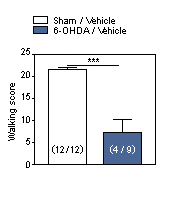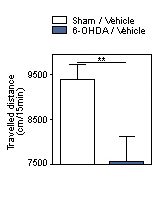PARKINSON'S DISEASE
-
Parkinson's disease (PD) is a neurodegenerative disorder with motor symptoms caused by the death of dopaminergic (DA) neurons in the striatum. As of yet, there is no medication to cure or halt this disease.
6-OHDA rats
Elevation in the amount of 6-hydroxydopamine (6-OHDA) has been reported in the urine of L-DOPA - treated Parkinson’s disease patients.
Unilateral injection of 6-OHDA in the rat brain produces lesion and depletion of striatal dopamine along with significant gait disturbance similar to those of PD patients.
This model is commonly used to the neuroprotective potential of new test compounds.
-
Compound testing
Neuroprotective compounds are usually tested in this model but other treatments could also be considered. Please feel free to contact us to discuss the feasibility of your study.
-
Endpoints
☐ Walking score in the beam walking test
☐ Forelimb asymmetry
☐ Locomotor activity
☐ Dopamine level
-
Motor deficits in 6-OHDA rats
-

Beam walking -

Locomotor activity
-
Depletion of striatal dopamine in 6-OHDA rats
-
GROUPS Dopamine level (ng/g of striatum) Sham 6783 (+/-) 600Vehicle - treated 6-OHDA ratsBelow the limit of quantification
You could also be interested in
-
Viability and survival tests
The survival test exploits the natural tendency of cells to die in culture and is therefore used to assess the neuroprotective properties of your compounds.
-
MPP+ and 6-OHDA (cellular model)
Parkinson’s disease is a neurodegenerative disease : ability of test compounds to inhibit MPP+ or 6-OHDA - induced cell damage in mesencephalic neuron cultures.
Haldol
Catalepsy is a well-known symptom of Parkinson's disease.
